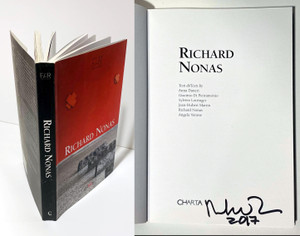
Richard Tuttle, The Art of Richard Tuttle (Hand signed, dated and inscribed by Richard Tuttle), 2005
Richard TuttleCONTACT GALLERY FOR PRICE
Richard Tuttle
The Art of Richard Tuttle (Hand signed, dated and inscribed by Richard Tuttle), 2005
Hardback monograph with dust jacket (Hand signed, dated and inscribed to Nadine by Richard Tuttle)
Hand signed, dated and inscribed to Nadine by Richard Tuttle in the half title page
12 1/4 × 11 1/2 × 1 1/2 inches
Unframed
This hardback monograph with dust jacket was hand signed for Nadine on the half title page at the opening reception of Systems, VIII-XII at Pace Gallery on September 6, 2012.
Book information:
Publisher : D.A.P./SF MOMA(July 15, 2005)
Hardcover : 392 pages with nearly 400 color illustrations
Publisher's blurb:
Over the past four decades, Richard Tuttle has thrown into question nearly every conceivable artistic convention and critical category to create an enormously inventive body of abstract work--one that embraces and intermingles drawing, painting, collage, book-making, sculpture and design. From his spare yet enigmatic forms of the 1960s to his complex, multi-faceted assemblages and installations of more recent years, Tuttle's primary impetus throughout has been to craft unique objects, using everyday, often ephemeral materials, that demand to be confronted on their own terms. The relentless individuality of his aesthetic vision has earned him standing as one of the most provocative and influential artists of his day. This richly illustrated and strikingly designed catalogue, the most authoritative volume ever published on this prolific artist, presents nearly 400 reproductions of artworks from across his oeuvre and documentary photographs of his creative process. Essays by a distinguished group of writers trace the arc of Tuttle's career from its inception in the 1960s to the present day, addressing topics such as the philosophical underpinnings of his artistic method; his sensitive handling of diverse materials; his lifelong engagement with drawing and its expansion into three-dimensional space; his groundbreaking solo exhibitions and their critical reception in the United States and Europe; his complex play with the conventions of language; and his innovative artist's books, many of which are collaborations with poets.
The Art of Richard Tuttle is published in conjunction with a major retrospective organized by the San Francisco Museum of Modern Art. The exhibition travels to the Whitney Museum of American Art, New York; the Des Moines Art Center; the Dallas Museum of Art; the Museum of Contemporary Art, Chicago; and the Museum of Contemporary Art, Los Angeles.
More about Richard Tuttle:
Richard Tuttle has revolutionized the landscape of contemporary art, challenging rules and notions of genre and media.
His work exceeds rational determinations, sensitizing viewers to perception and the unconscious, and engages aspects of painting, drawing, sculpture, bookmaking, printmaking, and installation.
Exposed to the Pop movement and the beginnings of Minimalism as a young artist, Tuttle began to explore the possibilities of material and form freed from historical allusion and precedent. Early investigations into the merging of painting and sculpture are evident in his Constructed paintings which exist in a liminal space between mediums. For Tuttle, the 1980s and 1990s marked wider experimentation with material and a move toward in-the-round constructions. He began incorporating the frame as an element in his compositions, collapsing the boundaries between the artwork and its surrounding space.
Tuttle’s engagement with scale, light, and systems of display have endured throughout his oeuvre and can be seen in his attention to marginal spaces such as floors, corners, and over door frames. Rejecting the rationality and precision of Minimalism, Tuttle embraced a handmade quality and the invention of forms that emphasize the occupation of these space along with volume. Over the course of his career, he has continued to overturn traditional constraints of material, medium, and method that engages a variety of traditional and non-traditional processes such as in his wire, small-scale collage, dyed cloth, and octagonal pieces.
Richard Tuttle draws beauty and poetry out of humble materials, creating works that exist in the present moment, reflect the fragility of the world, and allow for individual experiences of perception.
Courtesy of Pace Gallery




























